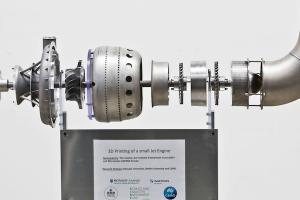
In 2015 Engineering Australia and others reported:
The world’s first 3D-printed jet engine was revealed to the world at the 2015 Melbourne International Airshow. The team, which included Safran, Monash University and Amaero, in collaboration with Deakin University and the CSIRO, took a Safran gas turbine power unit from a Falcon executive jet, scanned it and created two copies using their customised 3D metal printers.
“We proved that our team were world-leaders,” said Professor Xinhua Wu, Director of the Monash Centre for Additive Manufacturing. “I’m delighted to see our technology leap from the laboratory to a factory at the heart of Europe’s aerospace industry in Toulouse.”
Amaero will establish a new manufacturing facility on the Safran Power Units site in Toulouse using a 3D printing technology known as Selective Laser Melting. They will not only bring the know-how and intellectual property they’ve developed in partnership with Monash University, they will also relocate two of the large printers they have customised for this manufacturing task.
Safran Power Units will test and validate the components the team makes, and then the factory will enter serial production, producing components that Safran Power Units will post process, machine and assemble into auxiliary power units and turbojet engines for commercial and defence use. The project team expect that production will commence in the first quarter of 2017.
“Our new facility will be embedded within the Safran Power Units factory in Toulouse and will make components for Safran’s auxiliary power units and turbojet engines,” said Amaero CEO Barrie Finnin.
Monash has since formed a partnership with China's COMAC, signed in 2017, which committed both parties to work on the design of specialised new 3D printed alloys for the design and construction of the C919.
The security implications for SAFRAN are obvious, even if Monash VC Margaret Gardner refuses to see any danger of espionage.
TO BE READ WITH
Australian uni continuing work on Chinese plane linked to espionage claims
Monash and COMAC signed a $10 million research agreement in Beijing in October last year alongside Victorian Premier Daniel Andrews as he announced a second agreement with China under the Belt and Road Initiative.
It followed an earlier memorandum of understanding between Monash and COMAC, signed in 2017, which committed both parties to work on the design of specialised new 3D printed alloys for the design and construction of the C919.
Advertisement
Senior federal government sources said the university needed to be careful about collaborating on the design of a jet that has been linked to an allegedly significant industrial espionage campaign by the Chinese government.
Alex Joske, an analyst with the Australian Strategic Policy Institute, said COMAC's close ties to China's defence industry and military raised genuine concerns that its achievements will be used for both civilian and defence purposes.
Mr Joske said the fact COMAC was part-owned by defence companies makes it "nearly impossible" to separate civilian and military applications of joint research.
"Its links to state-backed industrial espionage are also alarming and associated risks will be extremely difficult for the university to handle," Mr Joske said.
"Monash University should also be wary of any commitments to train COMAC personnel. Universities should always seek to be fully aware of the risks of engaging with partners in China on dual-use technologies.
"I can't think of any realistic arrangement that would prevent dual-use collaboration with COMAC from ultimately being steered towards military uses."
Federal Education Minister Dan Tehan said the government expected universities to "act legally and ethically".
Mr Tehan said all universities have adopted the government's guidelines to counter foreign interference, which were published last year.
The guidelines included a recommendation for universities to "incorporate into existing relevant frameworks foreign interference threats and vulnerabilities to the university's people, information and assets and outline mitigation measures" and that universities have "policies and procedures [that] outline the requirements for staff, students, contractors and honorary staff engaging in international collaboration, proportionate to the risk".
A spokesman for Monash confirmed the agreements between the university and COMAC were "proceeding as planned" and included the design and construction of the C919 airliner.
"An Aeronautical Research Centre will also be established at the Monash Technology Precinct in Clayton," the spokesman said.
"Any collaborations with international entities are subject to strict national rules on research collaborations and Monash University has processes in place to ensure they comply with those rules.
"The University also regularly monitors advice provided by the government, intelligence agencies and the wider education sector, and acts in accordance with advice received."
In a report last year, cyber security firm CrowdStrike said the industrial espionage linked to COMAC involved cyber-attacks, forced technology transfer and theft by insiders at global component suppliers. The report concluded China was seeking to "cut corners" in advancing its domestic aerospace industry.
Mr Andrews witnessed the signing of last year's agreement between Monash and COMAC that will see the company invest in a new research and development centre at Clayton, which could pursue projects on advanced manufacturing, robotics, artificial intelligence, 3D printing and big data.
Senior figures within the Morrison government are also privately concerned with the Victorian government's BRI agreement with Beijing, which will allow for Chinese investment in Victoria and for Victorian companies to participate in Chinese government projects overseas.
Prime Minister Scott Morrison on Thursday said Victoria's BRI agreement was inconsistent with Australia's foreign policy, and urged Mr Andrews to scrap the deal.
Get our Morning & Evening Edition newsletters
The most important news, analysis and insights delivered to your inbox at the start and end of each day. Sign up to The Sydney Morning Herald’s newsletter here, to The Age’s newsletter here and Brisbane Times' here.
Share on Facebook
No comments:
Post a Comment